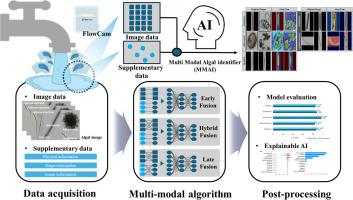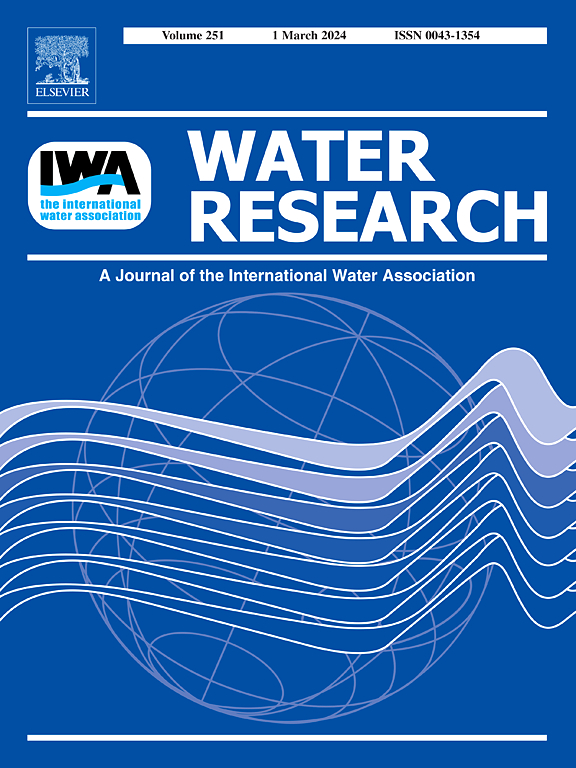Multi-modal learning-based algae phyla identification using image and particle modalities
IF 11.4
1区 环境科学与生态学
Q1 ENGINEERING, ENVIRONMENTAL
引用次数: 0
Abstract
Algal blooms in freshwater, which are exacerbated by urbanization and climate change, pose significant challenges in the water treatment process. These blooms affect water quality and treatment efficiency. Effective identification of algal proliferation based on the dominant species is important to ensure safe drinking water and a clean water supply. Traditional algae identification techniques, such as microscopy and molecular techniques, are time-consuming and depend on the expertise of the practitioner. This study introduced an artificial intelligence (AI)-based multi-modal approach, which is a recent advancement in techniques for improving algal identification by integrating algal images and particle properties. We employed multi-modal learning to integrate multiple data modalities, including algal images and particle properties acquired using Flow Cam, to provide robustness and reliability for classifying algal phyla, such as Anabaena, Aphanizomenon, Microcystis, Oscillatoria, and Synedra. This study involved acquiring images and particle modalities, which were conducted to integrate the dataset using early, late, and hybrid fusion methods. In addition, explainable AI approaches, including SHapley Additive exPlanations (SHAP) and gradient-weighted class activation mapping (Grad-CAM), were used to investigate the contributions of the algal image and particle modalities to the proposed multi-modal algorithm. The multi-modal algae identifier with late fusion achieved an average F1 score of 0.91 and 0.88 for training and tests related to identifying algal phyla, respectively. Furthermore, compared with other modalities, the image and particle modalities showed significant potential as complementary and reliable components of deep-learning algorithms for algal identification in the water treatment process. These findings can contribute to a safe and clean water supply by effectively identifying the dominant algal species in the water treatment process.

基于图像和粒子模态的多模态藻类门识别
城市化和气候变化加剧了淡水藻华,给水处理过程带来了重大挑战。这些水华影响水质和处理效率。根据优势种对藻类增殖进行有效识别,对确保饮用水安全、清洁供水具有重要意义。传统的藻类鉴定技术,如显微镜和分子技术,既耗时又依赖于从业者的专业知识。本研究介绍了一种基于人工智能(AI)的多模态方法,这是通过整合藻类图像和颗粒特性来提高藻类识别技术的最新进展。我们采用多模式学习来整合多种数据模式,包括使用Flow Cam获得的藻类图像和颗粒特性,为分类藻类门(如Anabaena, aphanizomens, Microcystis, Oscillatoria和Synedra)提供鲁棒性和可靠性。该研究包括获取图像和粒子模式,使用早期、晚期和混合融合方法整合数据集。此外,可解释的人工智能方法,包括SHapley加性解释(SHAP)和梯度加权类激活映射(Grad-CAM),用于研究藻类图像和粒子模态对所提出的多模态算法的贡献。经过后期融合的多模态藻类识别器在藻门识别训练和相关测试中的平均F1得分分别为0.91和0.88。此外,与其他模式相比,图像和粒子模式作为水处理过程中藻类识别的深度学习算法的互补和可靠组成部分显示出巨大的潜力。这些发现可以通过有效地确定水处理过程中的优势藻类物种来促进安全和清洁的水供应。
本文章由计算机程序翻译,如有差异,请以英文原文为准。
求助全文
约1分钟内获得全文
求助全文
来源期刊

Water Research
环境科学-工程:环境
CiteScore
20.80
自引率
9.40%
发文量
1307
审稿时长
38 days
期刊介绍:
Water Research, along with its open access companion journal Water Research X, serves as a platform for publishing original research papers covering various aspects of the science and technology related to the anthropogenic water cycle, water quality, and its management worldwide. The audience targeted by the journal comprises biologists, chemical engineers, chemists, civil engineers, environmental engineers, limnologists, and microbiologists. The scope of the journal include:
•Treatment processes for water and wastewaters (municipal, agricultural, industrial, and on-site treatment), including resource recovery and residuals management;
•Urban hydrology including sewer systems, stormwater management, and green infrastructure;
•Drinking water treatment and distribution;
•Potable and non-potable water reuse;
•Sanitation, public health, and risk assessment;
•Anaerobic digestion, solid and hazardous waste management, including source characterization and the effects and control of leachates and gaseous emissions;
•Contaminants (chemical, microbial, anthropogenic particles such as nanoparticles or microplastics) and related water quality sensing, monitoring, fate, and assessment;
•Anthropogenic impacts on inland, tidal, coastal and urban waters, focusing on surface and ground waters, and point and non-point sources of pollution;
•Environmental restoration, linked to surface water, groundwater and groundwater remediation;
•Analysis of the interfaces between sediments and water, and between water and atmosphere, focusing specifically on anthropogenic impacts;
•Mathematical modelling, systems analysis, machine learning, and beneficial use of big data related to the anthropogenic water cycle;
•Socio-economic, policy, and regulations studies.
 求助内容:
求助内容: 应助结果提醒方式:
应助结果提醒方式:


